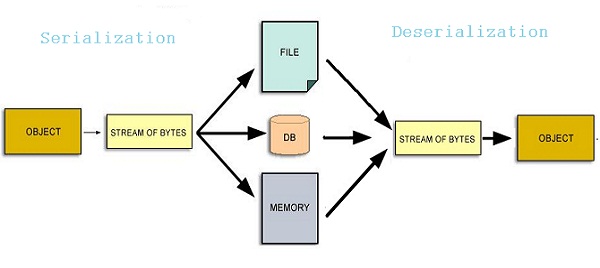Serialization and Deserialization in Java
Serialization is a process of converting an object into a sequence of bytes which can be persisted to a disk or database or can be sent through streams. The reverse process of creating object from sequence of bytes is called deserialization.
A class must implement Serializable interface present in java.io package in order to serialize its object successfully. Serializable is a marker interface that adds serializable behaviour to the class implementing it.
Java provides Serializable API encapsulated under java.io package for serializing and deserializing objects which include,
Marker interface
Marker Interface is a special interface in Java without any field and method. Marker interface is used to inform compiler that the class implementing it has some special behaviour or meaning. Some example of Marker interface are,
- java.io.Serializable
- java.lang.Cloneable
- java.rmi.Remote
- java.util.RandomAccess
All these interfaces does not have any method and field. They only add special behavior to the classes implementing them. However marker interfaces have been deprecated since Java 5, they were replaced by Annotations. Annotations are used in place of Marker Interface that play the exact same role as marker interfaces did before.
Signature of writeObject() and readObject()
writeObject() method of ObjectOutputStream class serializes an object and send it to the output stream.
public final void writeObject(object x) throws IOException
readObject() method of ObjectInputStream class references object out of stream and deserialize it.
public final Object readObject() throws IOException,ClassNotFoundException
while serializing if you do not want any field to be part of object state then declare it either static or transient based on your need and it will not be included during java serialization process.

Serializing an Object
import java.io.*;
class studentinfo implements Serializable
{
String name;
int rid;
static String contact;
studentinfo(string n, int r, string c)
{
this.name = n;
this.rid = r;
this.contact = c;
}
}
class Test
{
public static void main(String[] args)
{
try
{
Studentinfo si = new studentinfo("Abhi", 104, "110044");
FileOutputStream fos = new FileOutputStream("student.ser");
Objectoutputstream oos = new ObjectOutputStream(fos);
oos.writeObject(si);
oos.close();
fos.close();
}
catch (Exception e)
{ e. printStackTrace(); }
}
}
Object of Studentinfo class is serialized using
writeObject() method and written to student.ser file.Deserialization of Object
import java.io * ;
class DeserializationTest
{
public static void main(String[] args)
{
studentinfo si=null ;
try
{
FileInputStream fis = new FileInputStream("student.ser");
ObjectOutputStream ois = new ObjectOutputStream(fis);
si = (studentinfo)ois.readObject();
}
catch (Exception e)
{ e.printStackTrace(); }
System.out.println(si.name);
System.out. println(si.rid);
System.out.println(si.contact);
}
}
Output :
Abhi 104 null
Contact field is null because,it was marked as static and as we have discussed earlier static fields does not get serialized.
NOTE : Static members are never serialized because they are connected to class not object of class.
transient Keyword
While serializing an object, if we don't want certain data member of the object to be serialized we can mention it transient. transient keyword will prevent that data member from being serialized.
class studentinfo implements Serializable
{
String name;
transient int rid;
static String contact;
}
- Making a data member transient will prevent its serialization.
- In this example
ridwill not be serialized because it is transient, andcontactwill also remain unserialized because it is static.
No comments:
Post a Comment